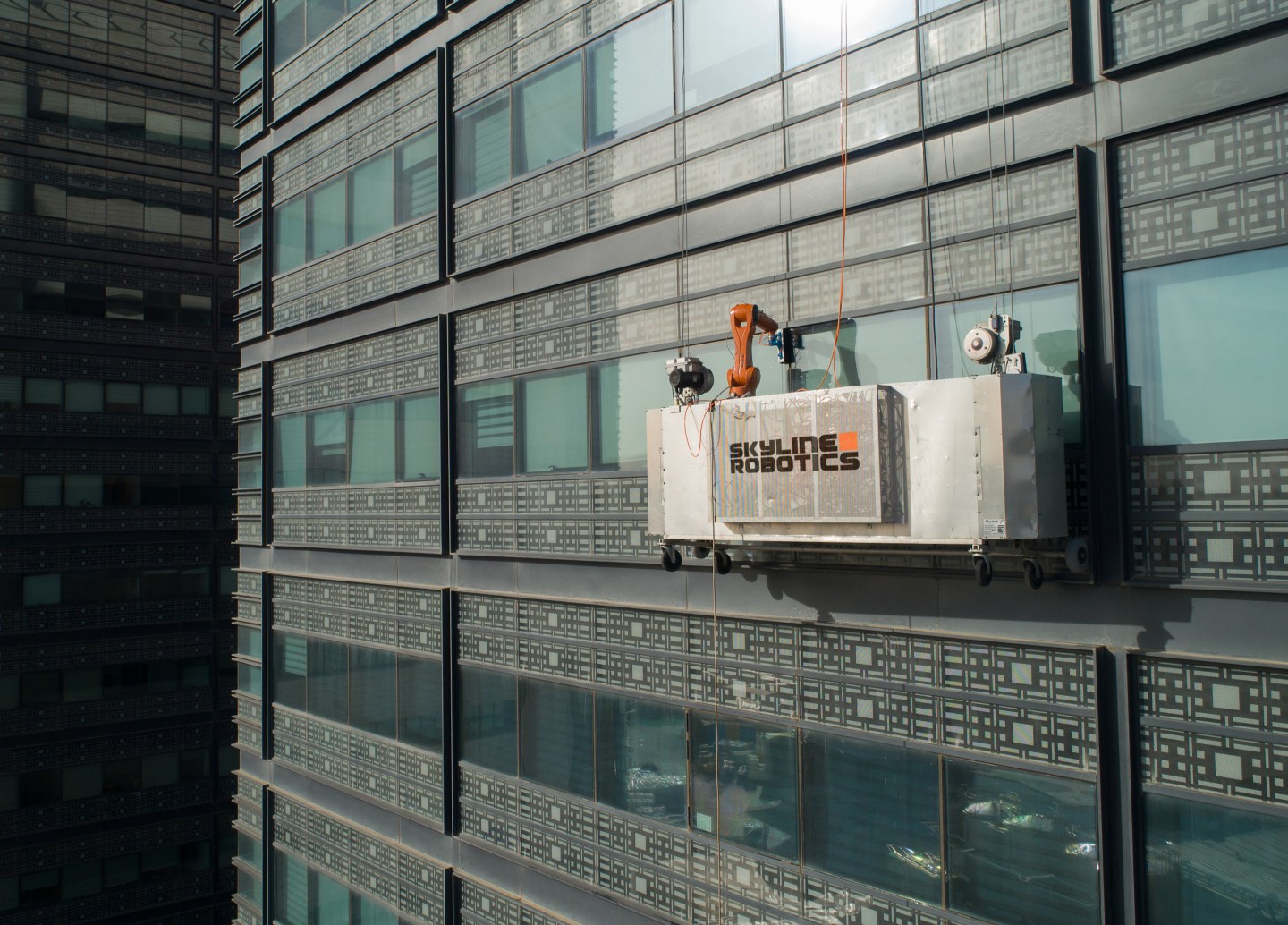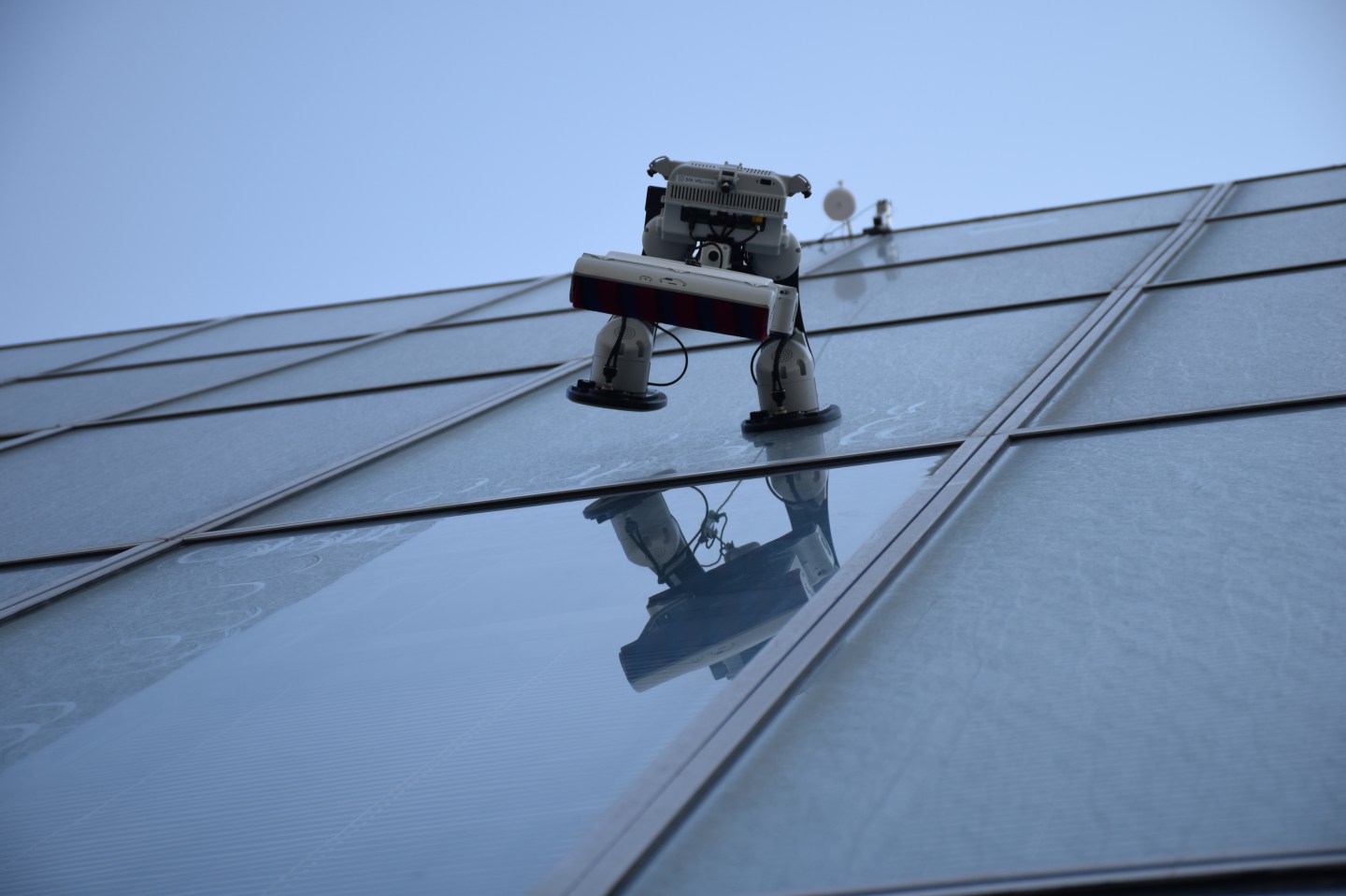又一行业被取代:人工智能机器人已经被应用于高空擦玻璃

2023年5月,我来到了全世界最高的住宅楼——美国纽约州纽约市中央公园大厦(Central Park Tower)顶层的露台。这栋大厦坐落在所谓的“富豪街”上,它也是全世界最高的建筑之一,其外墙材料主要是玻璃。我站在离地面1,416英尺(约431.597米)高的露台上,一边喝着香槟一边想:这么高的大楼,这些窗子得怎么才能够擦干净呀?
大楼外层清洁这种工作虽然危险,但终归是要有人做的。不过对于这种超高层的摩天大楼来说,做这份工作的有时竟然是机器人。
现在,有两家名叫Verobotics和Skyline Robotics的公司都盯上了规模达400亿美元的大楼外墙清洁市场。这两家公司打算利用人工智能机器人来模拟人类擦窗工人,从而让这份工作变得更加安全和高效。这种技术同时也可以应用于其他垂直墙面的维修保养。这两家公司都认为,通过将人工智能与硬件结合,这种技术在钢铁丛林般的城市中必然大有可为。
Verobotics公司的联合创始人及首席执行官伊多·吉诺萨说:“一栋建筑物的外层会对建筑物起到类似皮肤的保护作用,因此它也是建筑物的一个重要组成部分,它不仅关乎居住者的健康,也关乎建筑物的能源效率。不过令人意外的是,在过去一个世纪里,建筑物的外层维护技术几乎没有什么创新,只是维护成本变得越来越高。而我们的目标就是积极解决高楼大厦的维修保养问题,保护好城市高楼的‘皮肤’。”
该公司的机器人名为Ibex——这也是阿尔卑斯山地区的一种极善攀爬的野山羊的名字。这款机器人长得很像iRobot公司出品的一款全自动家用扫地机器人Roomba,但是二者的功能完全不同。Ibex有两条腿、5个摄像头和15个传感器,它能够在垂直墙面上自行攀爬,并且把自己固定在垂直墙面上。它还搭载了一个特殊的清洁模块,可以使用定制的刷子对大楼外墙进行清洁。只需一名操作员就能够控制四个Ibex机器人同时在大楼上进行外墙清洁工作。
当机器人进行清洁工作时,它还会使用多个传感器获取的原始数据来构建该建筑物的实时3D地图,包括它的详细状态。吉萨诺介绍道,如果在一年之内定期使用该机器人进行清洁的话,那么它还会及时更新该建筑物外层的变化,并且指出潜在问题,这样的话,我们就可以及时介入维修,免得“小洞不补大洞吃苦”。
吉诺萨说:“我们的机器人能够利用人工智能收集关于大楼外墙健康情况的系统性和一致性数据,使业主可以据此主动开展维保工作,并且根据问题严重程度提前做出维修计划,从而显著降低大楼外墙的维保成本。”
吉诺萨称,他的家族原本就是做建筑行业的,正是因为看到了大楼维保方面存在的局限性,他和公司的另一位创始人、首席技术官伊塔依·列维坦才开发了这套机器人系统。以前的外墙维保方案存在笨重昂贵、操作不便等缺点,另外,它们也没有为很多城市面临的气候变化问题做好准备。毕竟全球60%的最高建筑都是在过去13年中建成的。
吉诺萨指出,近年来,全球极端天气事件的发生频率有所增加,比如台风、暴雨等等,它们都会对建筑物造成影响。另一方面,在大风、高温、烈日等天气条件下进行大楼外墙的清洁工作,对工人而言也会更加危险。他表示,现在他的公司的大部分业务都集中在中国香港、新加坡、韩国首尔和日本东京等高楼大厦林立的城市。

而在美国纽约和英国伦敦,另一家名叫Skyline Robotics的公司也在思考如何在外墙维保领域实现创新。该公司于2023年10月刚刚在伦敦成立,但是现在,你已经能够在曼哈顿的哈德逊广场10号(10 Hudson Yards)和世贸中心7号(7 World Trade Center)等高楼大厦上看到它的机器人了。
Skyline公司的机器人名叫Ozmo,它的机械臂可以模仿人类的动作,而且它的擦窗速度是人类的三倍。Skyline公司的总裁兼首席运营官罗斯·布鲁姆表示,Ozmo能够将现场劳动力成本降低75%。
更重要的是,这些机器人还有助于解决高空作业人员短缺的问题,这也是摆在行业面前的一个现实困难。在百米高空擦玻璃显然是一项极其危险的工作,这就是为什么只有9%的高空擦窗工人的年龄在20岁至30岁之间。绝大多数高空作业工人的年纪都在40岁以上,而且他们都倾向于早早退休。
“他们必须把自己吊在离地1,000英尺(304.8米)的空中,做繁重的体力劳动,那里的温度可能是4摄氏度,也可能是40摄氏度。但无论如何,他们都必须完成自己的工作。”布鲁姆说,“而且现实情况是,这项工作的待遇也不是特别高,下一代也不愿意从事这项工作。”
布鲁姆指出,机器人为年轻工人带来了一种新的刺激——学习新技术,获得一种可以转化的技能。例如有了Skyline机器人后,擦窗工人现在已经能够和机器人协同工作了。“我们的技术不可能100%取代人类,人类总是有用武之地的。”
Ozmo搭载了一个六轴机械臂,其机械结构类似于人类的手臂关节结构。这款机器人是固定在一个工作台上的,而工作台则通过起重机或者吊架系统从屋顶上悬垂下来。远远看去,你甚至可能以为你头上有两名正在擦窗户的工人。但实际上,人类操控员是可以在大楼里面进行操控的,也能够在楼顶进行操控。
Ozmo的大部分决策都可以独自完成。它每秒钟能够计算250次,计算内容包括清洁时使用多大的压力,在哪里需要用刷子刷,以及什么时候把脚手架移动到下面一层。所有这些都是为了确定最有效的清洁路径。它还会评估建筑物的外层情况,并且就需要解决的问题提交数据。
布鲁姆表示,机器人节省下来的成本,以及收集的额外数据,对于维持这些高楼大厦的健康十分重要。有了这些机器人,大楼业主们就可以更经常地对大楼外层进行清洁、抛光和检查,并且科学地规化建设和维保项目。现在大多数高楼大厦的墙面检修周期是10年至15年,但布鲁姆相信,只要有条件,多数大楼的业主是希望缩短这个检修周期的。
“一个建筑物的预算大约有10%到20%分配给了墙面。换句话说,如果一栋大楼的造价是10亿美元,墙面就占2亿美元。墙面是大楼的脸面,所以你需要更经常地检修一下。”
比如,光是纽约市就有7,000多座高层建筑,其中高度超过650英尺(198.12米)的就有100座以上,超过1,000英尺(304.8米)的有16座。从我办公室的窗户向外望去,我就能够看见一座高达850英尺(259.08米)的新住宅楼的楼顶。它的外墙肯定时不时也需要清洗。
“如果有人在80层的位置买房,那他买的是在这个高度可以看到的景观。那么他们就必须得到一扇干净的窗子。”布鲁姆说道。(财富中文网)
译者:朴成奎
2023年5月,我来到了全世界最高的住宅楼——美国纽约州纽约市中央公园大厦(Central Park Tower)顶层的露台。这栋大厦坐落在所谓的“富豪街”上,它也是全世界最高的建筑之一,其外墙材料主要是玻璃。我站在离地面1,416英尺(约431.597米)高的露台上,一边喝着香槟一边想:这么高的大楼,这些窗子得怎么才能够擦干净呀?
大楼外层清洁这种工作虽然危险,但终归是要有人做的。不过对于这种超高层的摩天大楼来说,做这份工作的有时竟然是机器人。
现在,有两家名叫Verobotics和Skyline Robotics的公司都盯上了规模达400亿美元的大楼外墙清洁市场。这两家公司打算利用人工智能机器人来模拟人类擦窗工人,从而让这份工作变得更加安全和高效。这种技术同时也可以应用于其他垂直墙面的维修保养。这两家公司都认为,通过将人工智能与硬件结合,这种技术在钢铁丛林般的城市中必然大有可为。
Verobotics公司的联合创始人及首席执行官伊多·吉诺萨说:“一栋建筑物的外层会对建筑物起到类似皮肤的保护作用,因此它也是建筑物的一个重要组成部分,它不仅关乎居住者的健康,也关乎建筑物的能源效率。不过令人意外的是,在过去一个世纪里,建筑物的外层维护技术几乎没有什么创新,只是维护成本变得越来越高。而我们的目标就是积极解决高楼大厦的维修保养问题,保护好城市高楼的‘皮肤’。”
该公司的机器人名为Ibex——这也是阿尔卑斯山地区的一种极善攀爬的野山羊的名字。这款机器人长得很像iRobot公司出品的一款全自动家用扫地机器人Roomba,但是二者的功能完全不同。Ibex有两条腿、5个摄像头和15个传感器,它能够在垂直墙面上自行攀爬,并且把自己固定在垂直墙面上。它还搭载了一个特殊的清洁模块,可以使用定制的刷子对大楼外墙进行清洁。只需一名操作员就能够控制四个Ibex机器人同时在大楼上进行外墙清洁工作。
当机器人进行清洁工作时,它还会使用多个传感器获取的原始数据来构建该建筑物的实时3D地图,包括它的详细状态。吉萨诺介绍道,如果在一年之内定期使用该机器人进行清洁的话,那么它还会及时更新该建筑物外层的变化,并且指出潜在问题,这样的话,我们就可以及时介入维修,免得“小洞不补大洞吃苦”。
吉诺萨说:“我们的机器人能够利用人工智能收集关于大楼外墙健康情况的系统性和一致性数据,使业主可以据此主动开展维保工作,并且根据问题严重程度提前做出维修计划,从而显著降低大楼外墙的维保成本。”
吉诺萨称,他的家族原本就是做建筑行业的,正是因为看到了大楼维保方面存在的局限性,他和公司的另一位创始人、首席技术官伊塔依·列维坦才开发了这套机器人系统。以前的外墙维保方案存在笨重昂贵、操作不便等缺点,另外,它们也没有为很多城市面临的气候变化问题做好准备。毕竟全球60%的最高建筑都是在过去13年中建成的。
吉诺萨指出,近年来,全球极端天气事件的发生频率有所增加,比如台风、暴雨等等,它们都会对建筑物造成影响。另一方面,在大风、高温、烈日等天气条件下进行大楼外墙的清洁工作,对工人而言也会更加危险。他表示,现在他的公司的大部分业务都集中在中国香港、新加坡、韩国首尔和日本东京等高楼大厦林立的城市。
而在美国纽约和英国伦敦,另一家名叫Skyline Robotics的公司也在思考如何在外墙维保领域实现创新。该公司于2023年10月刚刚在伦敦成立,但是现在,你已经能够在曼哈顿的哈德逊广场10号(10 Hudson Yards)和世贸中心7号(7 World Trade Center)等高楼大厦上看到它的机器人了。
Skyline公司的机器人名叫Ozmo,它的机械臂可以模仿人类的动作,而且它的擦窗速度是人类的三倍。Skyline公司的总裁兼首席运营官罗斯·布鲁姆表示,Ozmo能够将现场劳动力成本降低75%。
更重要的是,这些机器人还有助于解决高空作业人员短缺的问题,这也是摆在行业面前的一个现实困难。在百米高空擦玻璃显然是一项极其危险的工作,这就是为什么只有9%的高空擦窗工人的年龄在20岁至30岁之间。绝大多数高空作业工人的年纪都在40岁以上,而且他们都倾向于早早退休。
“他们必须把自己吊在离地1,000英尺(304.8米)的空中,做繁重的体力劳动,那里的温度可能是4摄氏度,也可能是40摄氏度。但无论如何,他们都必须完成自己的工作。”布鲁姆说,“而且现实情况是,这项工作的待遇也不是特别高,下一代也不愿意从事这项工作。”
布鲁姆指出,机器人为年轻工人带来了一种新的刺激——学习新技术,获得一种可以转化的技能。例如有了Skyline机器人后,擦窗工人现在已经能够和机器人协同工作了。“我们的技术不可能100%取代人类,人类总是有用武之地的。”
Ozmo搭载了一个六轴机械臂,其机械结构类似于人类的手臂关节结构。这款机器人是固定在一个工作台上的,而工作台则通过起重机或者吊架系统从屋顶上悬垂下来。远远看去,你甚至可能以为你头上有两名正在擦窗户的工人。但实际上,人类操控员是可以在大楼里面进行操控的,也能够在楼顶进行操控。
Ozmo的大部分决策都可以独自完成。它每秒钟能够计算250次,计算内容包括清洁时使用多大的压力,在哪里需要用刷子刷,以及什么时候把脚手架移动到下面一层。所有这些都是为了确定最有效的清洁路径。它还会评估建筑物的外层情况,并且就需要解决的问题提交数据。
布鲁姆表示,机器人节省下来的成本,以及收集的额外数据,对于维持这些高楼大厦的健康十分重要。有了这些机器人,大楼业主们就可以更经常地对大楼外层进行清洁、抛光和检查,并且科学地规化建设和维保项目。现在大多数高楼大厦的墙面检修周期是10年至15年,但布鲁姆相信,只要有条件,多数大楼的业主是希望缩短这个检修周期的。
“一个建筑物的预算大约有10%到20%分配给了墙面。换句话说,如果一栋大楼的造价是10亿美元,墙面就占2亿美元。墙面是大楼的脸面,所以你需要更经常地检修一下。”
比如,光是纽约市就有7,000多座高层建筑,其中高度超过650英尺(198.12米)的就有100座以上,超过1,000英尺(304.8米)的有16座。从我办公室的窗户向外望去,我就能够看见一座高达850英尺(259.08米)的新住宅楼的楼顶。它的外墙肯定时不时也需要清洗。
“如果有人在80层的位置买房,那他买的是在这个高度可以看到的景观。那么他们就必须得到一扇干净的窗子。”布鲁姆说道。(财富中文网)
译者:朴成奎
In May, I set foot on the highest residential terrace in the world, the outdoor space of the penthouse at the Central Park Tower in New York City. A part of the so-called Billionaires’ Row, Central Park Tower is among the tallest buildings in the world, and its exterior is primarily glass. As I sipped a glass of Dom Pérignon standing 1,416 feet above the ground, alfresco, I looked back at the building and wondered: How do you clean these windows?
Someone has to wash the windows and polish the facade. For the super tall skyscrapers of the world, that someone is sometimes a robot.
Two companies, Verobotics and Skyline Robotics, are looking at making the estimated $40 billion window-washing industry safer and more efficient by using AI-driven robots to mimic the work of human window washers while also scanning the surface for necessary maintenance information for other facade-focused issues. By utilizing AI along with hardware, both companies are betting the vertical living of our urban environments is going to need a lot of TLC.
“The exterior of a building acts as its protective skin, a vital component that affects not only the well-being of its occupants but also the building’s energy efficiency,” said Ido Genosar, cofounder and chief executive officer of Verobotics. “Surprisingly, building exterior upkeep has seen little innovation in the past century, despite becoming more expensive. Our goal is to proactively address issues in how we maintain and safeguard the ‘skin’ of our cities’ rising skyscrapers.”
Genosar’s robot, dubbed Ibex after the wild goat known for its impressive climbing skills, looks similar to iRobot’s automated home vacuum Roomba but functions entirely differently. To start, Ibex suctions itself to the sides of buildings using two legs, five cameras, and 15 sensors so it can autonomously navigate a facade. A special payload attached to the robot is deployed for cleaning, using custom-built brushes. It’s all controlled by one operator, who can monitor up to four robots on a single building simultaneously.
While the robot cleans, it uses the raw data from the multiple sensors to build a real-time, 3D map of the building, including the state of the infrastructure. Genosar explained that when used regularly over the course of a year, the model updates with exterior changes and can highlight potential problems while they are small and manageable versus causing a bigger problem down the road.
“Using AI to gather methodological and consistent data on the building-facade health enables building owners to dramatically improve their proactive maintenance work and plan ahead for needed repairs based on severity,” Genosar said. “That reduces costs associated with maintaining a building’s facade.”
Genosar explained that he and his cofounder, Itay Levitan, who serves as chief technology officer, developed the robotic system after Genosar saw the limitations of current building maintenance options through his family’s construction business. Old solutions were bulky, heavy, and expensive, and beyond that, weren’t prepared for the changing climate and the resulting shift in weather patterns for many urban areas. Nor were they prepared for the heights of the world’s newest builds: 60% of the tallest towers were completed in the past 13 years.
The increased frequency of extreme weather events, such as typhoons and heavy rainstorms, has an effect on buildings, Genosar said. It’s more dangerous for window washers to clean amid these conditions—in terms of wind, heat, and sun—and it’s more likely to affect the overall structures. Much of his work, he said, is focused on Hong Kong, Singapore, Seoul, and Tokyo, well-known for their clusters of skyscrapers.
In New York and London, Skyline Robotics is working to rethink facade maintenance for the U.S. and Europe. The company just launched in London in October, but you can already see its robots on Manhattan towers such as 10 Hudson Yards and 7 World Trade Center.
Skyline’s robot, called Ozmo, has mechanical arms structured to mimic human movements and can clean windows three times as fast. The Ozmo also reduces on-site labor costs by 75%, according to Ross Blum, Skyline’s president and chief operating officer.
More important, said Blum, Skyline robots are helping to solve the labor shortage problem in the window-washing industry. It’s a risky job to hang hundreds of feet in the air and wipe down glass, so it’s not surprising that only 9% of window washers are between 20 and 30 years old. The vast majority are over 40 years old and likely to retire sooner than later.
“They have to hang 1,000-plus feet in the air, doing manual labor, and it can be 40 Fahrenheit or 110 degrees outside, but no matter what, they have to get the job done,” Blum said. “The reality is that the work isn’t incredible, and the next generation isn’t showing up.”
Blum explained that robotics offer younger workers a different incentive: to learn about new technologies and gain a transferable skill set. With Skyline, Blum sees window cleaners and robots working in tandem. “Our technology will never be used on 100% of buildings that exist; there is always room for a human workforce.”
Ozmo features a six-axis robotic arm with the same joints as a human arm. It’s placed on a table that’s secured to scaffolds suspended by cranes or davit systems from the roof. From far away, you may even think there are two window washers overhead. Instead, the human controllers are on firm footing in the building, where they can monitor from above.
Ozmo, however, makes most of its own decisions. It calculates 250 times per second to decide on such variables as how much pressure for cleaning, where to apply the brush, and when to move the scaffolding to the next level—all this to determine the most efficient cleaning path. It also takes stock of the building’s facade conditions and reports back data on potential issues that need to be addressed.
Blum explained that the cost savings and added data collected by robots is critical to the health of the world’s tallest buildings. When a building’s owner can implement cleaning, polishing, and inspections more often, they can best map out construction projects and repairs. Today, most facade checks occur on a 10- to 15-year cycle, but Blum believes most real estate owners would like a shorter time frame.
“Roughly 10% to 20% of a building’s budget is allocated to the facade of the structure; for a $1 billion building, that’s $200 million,” Blum said. “That’s the look of your asset. You want that checked with greater regularity.”
New York City, for instance, has more than 7,000 high-rise buildings, with more than 100 soaring higher than 650 feet and 16 buildings taller than 1,000 feet. From my window, I can crane my neck to see the top of a new residential tower that reaches almost 850 feet. It certainly will need cleaning from time to time.
“If someone is paying for space on the 80th floor of a building, they’re paying for the views from that vantage point,” Blum said. “They deserve clean windows.”













